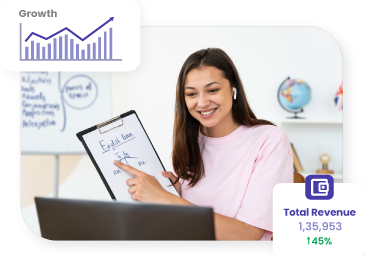Did you know that 74% of companies prioritize converting leads into customers as their top goal? It’s a challenge that everyone faces, business owners and creators alike. If you’re a creator, coach, or educator wondering how to convert a lead into a sale, you’re in the right place.
Lead conversion is not about luck or guesswork. It’s a methodical process that can be learned and repeated. By learning the right strategies, you can turn the leads you attract into real, consistent revenue. Whether you offer online courses, coaching services, or digital products, understanding and applying these strategies will help you build a more reliable income stream.
In this guide, we’ll share straightforward strategies, actionable tips, and tools to help you figure out how to convert a lead into a sale. Let’s get started.
What is Lead Conversion?
At its heart, lead conversion is all about turning interest into income. It’s the process of guiding someone from “this looks interesting” to “I’m in, where do I pay?”
As a content creator, your leads can come from anywhere: a person who replied to your Instagram story, someone who downloaded your free guide, or a visitor who signed up for your webinar. But not every lead is ready to buy right away, and that’s okay.
Think of it as a blend of art and science: you’re building trust, addressing needs, and creating a compelling case for why they should choose you. Here are the different kinds of leads you’ll usually come across:
- Curious but Cautious: These folks are following you, maybe engaging with your content, but haven’t taken any big steps. They’re watching, learning, and need a little more time and value before they act.
- Warm and Interested: They’ve signed up for your freebie, clicked a link, or booked a discovery call. They’re seriously considering your offer and just need clarity, confidence, or a small nudge.
- Cold or Dormant: Maybe they followed you months ago or downloaded something, but never engaged after. You must rewarm them with helpful content or a quick personal touch.
Knowing the difference helps you respond better. Push too hard too soon, and you might lose trust. Wait too long, and they may buy from someone else. Lead conversion is where your content, communication, and confidence turn into sales. Done right, it creates income and impact without pressure or burnout.
With the stakes clear, let’s move on to crafting a process that ensures success.
How to Build a Lead Conversion Process as a Creator?
Turning leads into paying customers isn’t a random process. It requires a clear, step-by-step approach that helps you stay organized and focused. By setting up a solid lead conversion process, you’ll know exactly what to do at each stage, making it easier to turn casual followers into loyal buyers.
Here’s how to build a lead conversion process that works for you, whether you’re a coach, educator, or digital product creator:
Step 1: Design a Sales Funnel
Your sales funnel is the map that guides your leads from their first interaction with you to becoming a paying customer. For creators, the stages might look a little different, but the principle remains the same: you need to nurture leads and build trust at each step.
- Awareness: This is when people first hear about you, whether it’s through your YouTube videos, Instagram posts, or blog. They’re not sure what they need yet, but they start to recognize the value you offer.
- Interest: Now they’re engaging more, watching your free webinars, reading your content, or joining your email list. They’re becoming more curious and open to learning from you.
- Decision: Here, they’re actively considering your offering. They might be comparing your courses or coaching to others or reaching out to ask more specific questions.
- Action: This is the goal, when a lead decides to purchase your course, sign up for your coaching, or buy your digital products. You’ve successfully converted them into a paying customer.
Tip: Tweak your messaging to fit each stage. A free resource might work at the awareness stage, while a success story or detailed case study could be more effective for leads in the decision phase.
Once your funnel is in place, the next step is to ensure you’re focusing on the right leads, not just every lead.
Step 2: Qualify Your Leads
Not all leads are created equal. You’re working with limited time and resources, so you want to focus on the leads most likely to convert into paying customers. Use a simple qualification framework like BANT (Budget, Authority, Need, Timeline) to assess your leads:
- Budget: Can they afford your offering? For creators, this means understanding whether they’re ready to invest in your course, coaching, or digital products.
- Authority: Are you talking to the decision-maker? Make sure you’re engaging with the person who can say “yes” to a purchase.
- Need: Does your offering solve a real problem for them? If your product isn’t what they need, it’s time to move on.
- Timeline: Are they ready to take action now, or is this a future purchase? Knowing their urgency helps you prioritize effectively.
After you’ve qualified your leads, the next logical move is to monitor how they interact with your brand over time.
Step 3: Track Lead Progress

Visibility is key. Use a CRM or even a detailed spreadsheet to monitor:
- Interactions: Record how often a lead engages with you. Whether they’re opening your emails, watching your videos, or commenting on your posts.
- Stage Movement: Keep track of when leads move from one stage to the next. Are they progressing from interest to decision, or do they get stuck at a certain point?
- Personal Details: Note their pain points, preferences, or specific questions they’ve asked. This helps you customize your outreach.
Tracking enables you to identify bottlenecks, like leads stalling after a demo, and adjust accordingly. After you’ve qualified your leads, the next logical move is to monitor how they interact with your brand over time.
If you’re managing all of this manually, it might be time to simplify. Exly makes tracking every customer touchpoint easy, automating key steps in your funnel, and managing your leads with built-in CRM tools. It’s a great way to save time while staying organized and focused on conversions.
Step 4: Set Clear Milestones
Every stage in your funnel should have a clear, measurable goal. Milestones help you track progress and stay on target. For example:
- Awareness Stage: A milestone might be getting someone to sign up for your email list or download a free resource.
- Action Stage: The final milestone is when they purchase or sign up for a coaching program.
Defining these milestones ensures your strategy stays on track and motivates you and your team (or your solo efforts) to keep pushing forward. Once your milestones are defined, assign responsibility for carrying them out, whether it’s just you or a small team.
Step 5: Assign Roles and Ownership
Even if you’re working solo, it’s important to define what role you’ll play in each stage of the funnel. If you’re handling everything yourself, set clear boundaries for when you focus on content creation, nurturing leads, or following up with prospects.
- For example, content creation (like blog posts or social media) is critical at the awareness stage, while personalized email follow-ups are more suited to the decision stage.
- If you’re collaborating with a small team, delegate tasks based on strengths. Maybe one person is great at creating content, while another excels at customer communication.
By defining roles, even in a small team, you’ll ensure that leads get the attention they need and nothing falls through the cracks.
With this process in place, you’ve got a blueprint for repeatable success. Next, let’s explore strategies for converting a lead into a sale.
Effective Lead Conversion Strategies

A solid process is just the start, and now it’s time to apply strategies that turn leads into customers. These are hands-on, results-driven tactics you can implement today.
1. Craft Engaging Content
As a creator, your content works around the clock to build trust and guide leads toward making a purchase. Here’s how you can maximize its impact:
- Solve Real Problems: Address your audience’s specific pain points. For example, if you’re an online fitness coach, create content like “5-Minute Morning Stretch Routine for Busy People,” solving a problem your audience faces daily.
- Showcase Your Value: Use testimonials, success stories, or tutorial videos to highlight how your product or service has helped others. If you’re a course creator, share snippets from a module to give them a taste of what they’ll learn.
- Vary Your Formats: Not all of your leads will engage with the same type of content, so mix it up! Share blog posts, Instagram reels, or podcast episodes to keep things fresh and cater to different preferences.
- End with Action: Every piece of content should nudge leads closer to making a purchase. For instance, include a CTA like “Sign up for my free coaching session today” or “Download your free resource now.”
Once your content is doing the heavy lifting, the next step is making sure your CTAs are just as persuasive.
2. Build Strong CTAs
Your call-to-action is the turning point where your audience shifts from interested to invested. If you get your CTAs right, you’ll guide leads through the conversion process smoothly. Here’s how to make your CTAs compelling:
- Be Clear and Specific: Don’t settle for generic phrases like “Click Here.” Instead, be clear about what’s in it for them. Use phrases like “Claim Your Free Strategy Session” or “Get Access to This Exclusive Course Today.” This makes it obvious what the lead will get by taking action.
- Create Urgency: Lead conversion is often about timing. Urgency can spur leads to act now instead of later. Use phrases like “Only 5 Spots Left” or “Offer Ends in 24 Hours” to create a sense of urgency and push them to make a decision.
- Place CTAs Strategically: Ensure your CTAs appear where they’ll have the most impact. For instance, after a successful client story, place a CTA that says, “Ready to See the Same Results? Book a Free Consultation.” You can also use pop-ups on your most-visited pages or include CTAs in your email signature.
- A/B Test CTAs: Just like content, your CTAs need testing. Experiment with different button texts, colors, or placements to see which ones perform the best. For instance, test “Join Now” against “Start Your Journey” and see which gets more clicks.
Even with perfect CTAs, slow responses can cost you leads, so let’s fix that next.
3. Speed Up Responses
Lead conversion is all about timing. The quicker you respond, the more likely you are to convert a lead. Here’s how to speed up your response time without sacrificing quality:
- Automate First Contact: Set up tools like email autoresponders or chatbots to reply instantly when a lead reaches out. A quick “Thanks for contacting me! I’ll get back to you shortly” goes a long way in making leads feel valued and attended to.
- Flag High-Intent Leads: Not all leads are equal. Prioritize leads that show high intent, like those who’ve booked a consultation or requested a demo. Set up notifications for these actions so you can follow up right away while they’re still hot.
- Use Templates for Common Inquiries: Save time with email templates for frequently asked questions or common responses. This streamlines your communication, making it easy to send quality responses without starting from scratch each time.
- Ensure Availability: Even if you’re a solo creator, make sure there’s always someone available to respond. Set aside specific hours for checking emails, social media, or your chat inbox. If you can, consider outsourcing or using a virtual assistant to handle inquiries during off-hours.
Once you start responding in the right way, the next step is to personalize your approach to build trust.
4. Personalize Your Approach
One-size-fits-all pitches rarely work, especially in the world of content creation. Personalization is key to building deeper connections with your leads. Here’s how to modify your outreach:
- Be Specific: Mention specifics about your leads, such as their name or past interactions. For example, “Hi Sarah, since you loved our recent Instagram live, here’s an exclusive discount for our course.”
- Segment Your Audience: Group leads by behavior, interests, or goals. If you’re a designer, you could target leads with a “Freelance Designer Essentials” guide or “How to Build a Personal Brand as an Artist.”
- Focus on Their Needs: If a lead asks about pricing, respond with an offer or discount. If they’re more interested in the content, dive into the course details.
- Add a Personal Touch: Small gestures like “Hi Emma, I thought you’d love this productivity hack since you’re juggling so much” make your interactions feel more thoughtful and tailored.
Personalization helps build trust, but to scale effectively, the right tech stack is crucial.
5. Using Technology and Tools

Technology is essential for staying competitive in lead conversion. The right tools streamline workflows, uncover insights, and keep you ahead of the game. Here’s how to convert a lead into a sale using the right tools.
CRM Systems
A Customer Relationship Management (CRM) system is your hub for managing leads effectively. It’s like having a personal assistant who never sleeps. Key CRM features for creators include:
- Centralized Data: Store all your contact info, conversation history, and preferences in one place.
- Pipeline Management: Visualize your leads’ journey, from first contact to conversion, and move them smoothly through the funnel.
- Automation: Set up automatic reminders for follow-ups or send personalized emails based on actions, such as downloading a free guide.
- Reporting: Track your conversion rates, monitor your sales pipeline, and measure campaign performance to see what’s working.
Automation Tools
Automation frees you from repetitive tasks, letting you focus on closing deals. Here’s what it can do:
- Drip Campaigns: Send a series of emails, like a welcome note, a success story, then a discount, based on lead behavior.
- Lead Scoring: Rank prospects by actions (e.g., 10 points for a page visit, 50 for a demo request) to prioritize follow-up.
- Chatbots: Answer FAQs or gather info 24/7, qualifying leads even when you’re offline.
- Workflow Triggers: Automatically notify sales when a lead hits a key milestone, like downloading a pricing guide.
Analytics Platforms
Data-driven decisions beat gut feelings every time. Analytics tools reveal what’s working and what’s not:
- Conversion Tracking: Pinpoint how many leads become customers and where drop-offs occur.
- Source Analysis: Identify which channels (e.g., LinkedIn ads vs. organic search) deliver the best leads.
- Behavioral Insights: Use tools like Google Analytics or Hotjar to track where your leads are clicking, how long they stay on your page, and what content they engage with most.
- A/B Testing: Test different versions of your landing pages or email subject lines to see what resonates with your audience.
Managing leads on your own can be overwhelming, but it doesn’t have to be. With Exly, you can handle CRM, automation, and analytics all in one place, freeing you up to focus on growing your content and connecting with your audience.
Now that you’ve figured out your tech setup, you should focus your attention on optimizing sales tactics.
6. Optimizing Sales Tactics
Your sales tactics are the final nudge that seals the deal. Fine-tuning them can mean the difference between “maybe later” and “sold.” Here’s how to sharpen your approach.
- Refine Your Pitch: Tailor your pitch to each lead’s specific needs. Instead of just listing features, focus on outcomes. For example, “You’ll never struggle to organize your schedule again with our tool” is far more compelling than just listing its features.
- Use Data Insights: Regularly review your conversion data to see what’s working. If certain emails or pitches are consistently converting better, make those your go-to approach.
- Train for Consistency: As a solo creator, you must deliver consistent, high-quality outreach. Practice your pitch and objection handling until it feels natural, and make sure your follow-up process is clear and replicable.
Finally after optimizing your tactics, the last step is to maintain and nurture leads.
7. Maintaining and Nurturing Leads
Not every lead converts right away; some need time to ripen. Nurturing ensures they don’t forget you. Here’s how to stay connected.
- Email Campaigns: Create a series of nurturing emails that provide valuable content and gradually introduce your offers. Start with educational content, followed by tips, success stories, and then a soft pitch for your product or service.
- Content Sharing: Share new blog posts, videos, or updates that align with their interests, keeping you top of mind without being overly sales-focused.
- Social Media Interaction: Engage with leads on your social platforms. Respond to comments quickly, share customer stories, or host live Q&A sessions to build trust and rapport.
With the core strategies outlined above, you’re prepared to convert leads into sales. However, you might run into potential pitfalls.
Common Lead Conversion Challenges Creators Face (And How to Overcome Them)

As a creator, turning leads into customers isn’t always straightforward. While the process may seem simple in theory, many creators face unique challenges along the way, especially when managing everything independently. Here are some common mistakes and challenges in lead conversion, along with tips to overcome them:
1. Not Nurturing Leads Consistently
One of creators’ biggest mistakes is assuming that a single interaction will convert a lead into a paying customer. In reality, leads need to be nurtured through multiple touchpoints before they make a purchase decision.
How to Overcome It:
- Create a lead-nurturing sequence: Set up automated email campaigns or follow-ups to stay connected with your leads. This ensures that you’re top of mind when they’re ready to take action.
- Engage on social media: Regularly interact with leads on platforms where they’re most active. Reply to comments, send DMs, or host live Q&As to keep the conversation going.
2. Lack of Personalization
Generic messages and a one-size-fits-all approach rarely convert well. Your audience expects personalized communication, especially if they’ve engaged with you in a specific way.
How to Overcome It:
- Segment your audience: Break down your leads into smaller groups based on their interests, behavior, or stage in the funnel. This allows you to send tailored messages that speak directly to their needs.
- Use their name and preferences: Simple touches like addressing leads by name or referencing their specific interests or past actions can make a big difference in engagement.
3. Failure to Qualify Leads Properly
Not all leads are created equal. Many creators waste time nurturing leads that have little potential to convert. Understanding who your ideal customers are and qualifying them early can save you a lot of time and energy.
How to Overcome It:
- Use a qualification framework: Implement a system like BANT (Budget, Authority, Need, Timeline) to assess leads early on and prioritize the ones most likely to convert.
- Focus on high-intent actions: Pay close attention to leads who take actions like signing up for a free session, attending a webinar, or downloading a free resource. These are often signs of high interest.
4. Not Using the Right Tools to Automate
Managing leads manually can be overwhelming, especially when you’re juggling content creation, marketing, and customer support. Without the right tools, lead conversion can quickly become a time-consuming process.
How to Overcome It:
- Leverage all-in-one platforms: Use tools like EXLY to streamline your lead management. With CRM, automation, and analytics all in one place, you can save time while effectively nurturing leads.
- Automate follow-ups: Set up automated email sequences, task reminders, and follow-up emails to ensure no lead falls through the cracks.
5. Lack of Clear Calls to Action (CTAs)
If you don’t make it clear what the next step is for your leads, they’ll often just walk away. Clear, compelling CTAs are essential for converting interest into action.
How to Overcome It:
- Be direct with your CTAs: Don’t leave your leads guessing what to do next. Use CTAs like “Book Your Free Session” or “Start Your Course Today” to guide them through the next steps.
- Add urgency: Including phrases like “Limited-time offer” or “Only a few spots left” encourages leads to act quickly.
6. Ignoring the Power of Social Proof
Social proof (like testimonials, reviews, or case studies) is key to building trust in content creation. Leads are more likely to convert when they see that others have had positive experiences with your services or products.
How to Overcome It:
- Share success stories: Showcase testimonials from clients or students who have benefited from your courses, coaching, or digital products.
- Use case studies: Include specific examples of how your offering has helped someone achieve their goals.
How Exly Helps Creators Like You to Convert Leads Into Sales?
As a creator, you don’t have time to chase every lead manually, and with Exly, you don’t have to. Exly gives you everything you need to capture, nurture, and convert leads from one clean dashboard.
- Built-in CRM to track and manage your leads in real time
- Automated follow-ups and email workflows that run while you focus on content
- Segmentation tools to personalize communication based on lead behavior
- High-converting landing pages and CTAs you can launch in minutes
- Performance tracking so you know what’s working (and what’s not)
Whether you’re selling coaching sessions, digital products, or courses, Exly helps you move leads down the funnel with less guesswork and more results. So, focus on creating and let Exly handle the conversions.
Conclusion
Converting leads into sales isn’t out of reach. By putting a structured plan in place, using the right strategies, and applying the best tools available, you can create a smooth and predictable process that turns prospects into loyal customers. Each action will build on the other, leading to consistent growth.
Ready to make lead conversion work for you? Exly’s all-in-one platform helps you streamline your workflow, manage leads, and automate key tasks. Take control of your lead management today and start seeing the results you deserve. Take the first step today, explore Exly, and watch your conversions soar.
FAQ
Q1. What does it mean to convert a lead into a sale?
Converting a lead into a sale means guiding someone who’s shown interest in your product or service, through actions like signing up for a newsletter or requesting a quote, to complete a purchase.
Q2. How do I know which leads are worth focusing on?
Use a qualification framework like BANT (Budget, Authority, Need, Timeline) to prioritize leads. Focus on those with the budget, decision-making power, a clear need for your solution, and an urgent timeline.
Q3. Why is responding quickly to leads so important?
Speed matters because leads are most engaged right after they reach out. Quick replies show you value their interest and keep you ahead of competitors who might be slower to follow up.
Q4. What’s the best way to nurture leads who aren’t ready to buy?
Keep them engaged with drip email campaigns offering value (tips, case studies), relevant content like webinars, and social media interactions (comments, polls).





